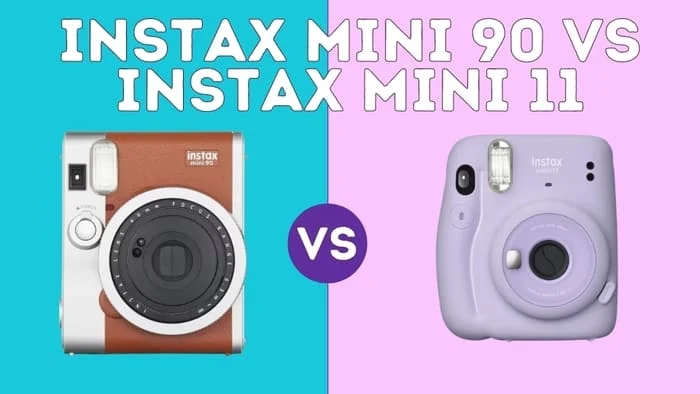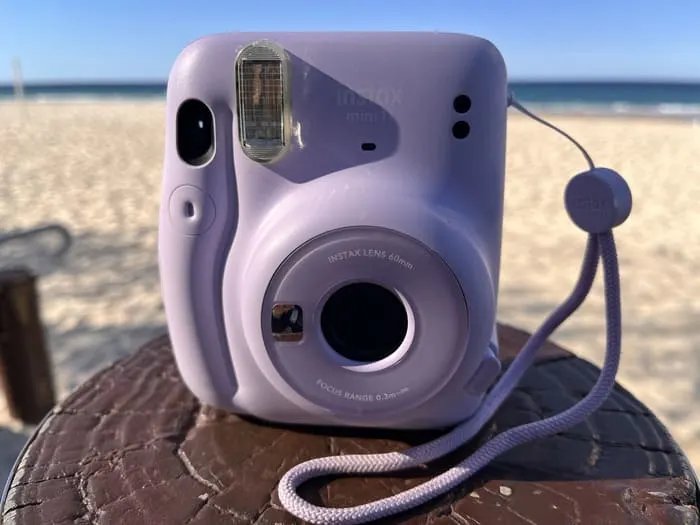As an instant camera enthusiast, I know that choosing the right camera can be daunting, especially when so many options are available. Fujifilm’s Instax Mini cameras are top-rated, but with so many models, it can be tough to know which one to pick.
The Instax Mini 11 – released in 2020 – is among the most popular of their newest models.
At the same time, older models like the Instax Mini 90 Neo Classic retain their popularity, especially among people who enjoy the more classic design.

In this article, I will share my experience with the Instax Mini 11 vs 90 Neo Classic to help you decide which is best for you.
Instax Mini 90 vs. Mini 11 – Which Is Better?

Though the Instax Mini 11 and Instax Mini 90 may seem relatively similar, they’re pretty different when you get down to it.
The Instax Mini 90 has significantly greater functionality and offers more control over your photography. In contrast, the Instax Mini 11 is an attractive, lightweight, easy-to-use camera perfect for personal use.
The choice between the two instant cameras depends on what you hope to get from your camera. If you choose an Instax based on your needs, you’re unlikely to be disappointed with either option.
Comparing The Two Cameras
Because of the separation between release dates, the Instax Mini 11 and the Instax Mini 90 Neo Classic differ.
However, they have some similarities – both are about the same weight, and the picture sizes are identical (62mm x 46 mm). This similarity means you can use the same film for both cameras – the Instax Mini film.
The lenses are similar on the face of it – they are both two-element 60 mm lenses that can capture images from 0.3 m to infinity. There are some differences in the lenses, which we’ll discuss below.
However, beyond these surface-level similarities, a few things separate them. Let’s start with the technical specifications.
General Specifications
Let’s look at the specs of both cameras.
Fujifilm Instax Mini 11
- Dimensions: 4.24 x 4.77 x 2.65 inches
- Batteries: 2 AA
- Film format: 2×8
- Flash: Yes
- Viewfinder Type: Optical
Fujifilm Instax Mini 90
- Dimensions: 3.61 x 2.25 x 4.5 inches
- Batteries: 1 Lithium-Ion
- Film format: 6×8
- Flash: Yes
- Viewfinder Type: Optical
It’s important to note that technical specifications only tell a tiny part of the story. Let’s look at these cameras in further detail.
Design
The Instax Mini 11 is designed to look more playful and whimsical than the Instax Mini 90. It’s a bit chunkier than other models but still pretty comfortable. The playfulness of the model is also evident in the range of colors in which it is available – these include:
- Ice white
- Sky blue
- Bluish pink
- Charcoal gray
- Lilac Purple
On the other hand, the Mini 90 Neo Classic is designed to have a far more classic appeal. It looks similar to a vintage camera, and the faux leather wrap only adds to this design. Unlike the Instax Mini 11, it is available in only a few colors – black, brown, and red (now discontinued).
One significant design difference between the two is the LCD indicator panel.
The Mini 11 does not have this type of panel, while the Instax Mini 90 Neo Classic’s panel displays relevant information you may need while using the camera.
This makes it much easier to monitor your settings and includes an exposure counter (which counts off how many shots you have left), a brightness control and mode button, and more.
Additionally, the location of the light sensors on the two cameras is different.
The sensors on the Instax Mini 11 are on the camera’s body, while the ones on the Instax Mini 90 are on the lens.
This makes it easier to cover the sensors on the Instax Mini 11 compared to the Instax Mini 90 Neo-Classic – and this is a crucial point to keep in mind because hidden light sensors can result in white images and wasted film.
The Instax Mini 90 also has a tripod socket on the bottom, which is excellent if you plan to attach it to a tripod mount. Unfortunately, the Instax Mini 11 is missing this socket, making distant self-photography challenging.
Further Spec Details
Both cameras use the same 60 mm lens, as discussed earlier, and both have automatic flash functionality. However, the Instax Mini 11 has a constant firing flash that you cannot turn off, while the Instax Mini 90 offers several flash options, including forced firing mode, flash with red-eye removal, and no flash at all.
Using the Instax Mini 11 in high-brightness environments may be more challenging, while the Instax Mini 90 will work better and give you more creative control over your images.
The other difference comes in selfie mode.
Though the Instax Mini 90 Neo Classic is the higher-end model, the Instax Mini 11 has a one-touch selfie mode and a selfie mirror.
However, all is not lost if you prefer the Instax Mini 90 and are also a selfie enthusiast – the shutter button on the Instax Mini 90 can act as a selfie mirror if needed.
Aside from the selfie mode, the other shooting mode in the Fujifilm Instax Mini 11 is the macro mode, perfect for taking closer images of your subject.
The Instax Mini 90 Neo Classic, on the other hand, features many shooting modes, including
- Kids Instant Camera Mode: It is tailored to allow you to capture fast-moving subjects, like animals and children, quickly.
- Landscape Mode: The landscape mode is for taking images at a distance – it works best from 3 m to infinity.
- Macro Mode: For close-up photography between 30-60 cm.
- Party Mode: To ensure both the background and subject are captured in vivid and bright colors.
- Bulb Exposure Mode: If you’re a fan of light streak photography, the bulb exposure mode is perfect. It’s also suitable for capturing night views and works by ensuring the shutter remains open for up to 10 seconds when the button is pressed.
- Double Exposure Mode: To activate the dual exposure mode, you’ll have to select it and press the shutter button twice. This allows you to combine two images into a single photo, superimposing one shot over the other – thus giving you double exposure.
Additionally, the brightness control helps you decide how bright each image will be.
Price
Aside from the technical features, the price is another important consideration that affects the choice of which camera to buy.
Between the two models, the Instax Mini 90 Neo Classic is the more expensive option – depending on where you buy your camera from, it can be as much as double the price of the Mini 11.
The Mini 90 Neo Classic also comes with many features unavailable with the Mini 11. So, the price point debate also heavily depends on what functionality you’re looking for from your camera.
Other Considerations
Instax Mini 90 Neo Classic

The Instax Mini 90 is a great instant camera for more experienced photographers.
It offers a ton of options and excellent image quality. However, it should be noted that these options can also backfire – the trial-and-error nature of getting used to this variety means you can burn through a few packets of Instax Mini film before you’re comfortable with it.
This camera is a good option for artistic photographers looking to spend some time experimenting with choices. Though it’s a fantastic camera overall, the price may dissuade some buyers who would be okay with fewer features for a better price.
Instax Mini 11

If you’re looking for an easy-to-use instant camera appropriate for people regardless of their photography skills, the Instax Mini 11 is the right choice. This instant camera is a fundamental, point-and-shoot model that produces good-quality images.
Read next: Instax Mini 9 vs 11: Which Instant Camera Reigns Supreme?
The fun color options make it attractive to younger buyers, and the affordable price point means that it works well as an introduction to instant cameras.
The inability to disable the flash may cause some issues, but the added selfie mode makes up for it. Ultimately, a good starter camera at a great price.
Fujifilm Instax Mini 11 vs. Fujifilm Instax Mini 90: At A Glance

| Camera Model | Fujifilm Instax Mini 90 | Fujifilm Instax Mini 11 |
| Printing Method | Film | Film |
| Picture Size (without border) | 2.4” x 1.8” | 2.4” x 1.8” |
| Picture Size (with border) | 3.4” x 2.1” | 3.4” x 2.1” |
| Picture Format | 3:2 | 3:2 |
| Paper Capacity | 10 | 10 |
| Film Type | Instax Mini Instant Film | Instax Mini Instant Film |
| Film Developing Time | 90 second | 90 seconds |
| Flash | Yes | Yes |
| Deactivate Flash | Yes | No |
| Focal Length | 60mm | 60mm |
| Focus Type | Manual Focus | Fixed Focus |
| Buy From Amazon | Instax Mini 90 | Instax Mini 11 |
FAQs
Is The Instax Mini 90 Discontinued?

The Instax Mini 90 is still active and is readily available in online and offline stores. The only discontinued model is the red color variation of the camera, though you may still be able to find it secondhand.
Is it Worth it to Buy Instax Mini 11?

Yes! The Instax Mini 11 is available for a great price and is worth it if you’re looking for an introduction to instant cameras. Although it’s not as feature-rich as other options, including the Mini 90, the affordability makes up for the fewer features.
While professional photographers and photography enthusiasts will likely prefer the Mini 90, the Mini 11 is perfect for most other people.
Instax Mini 90 vs 11 – My Verdict
The Instax Mini 11 and Instax Mini 90 Neo Classic are excellent cameras. The choice between the two cameras depends on your needs and preferences. If you’re a beginner looking for an easy-to-use instant camera, the Mini 11 is a great option.
However, if you’re an experienced photographer looking for more control over your images, the Mini 90 Neo Classic is the way to go. Whatever you choose, you’re unlikely to be disappointed with either option.
READ NEXT: Instax Mini 70 vs Mini 11: 7 Key Differences